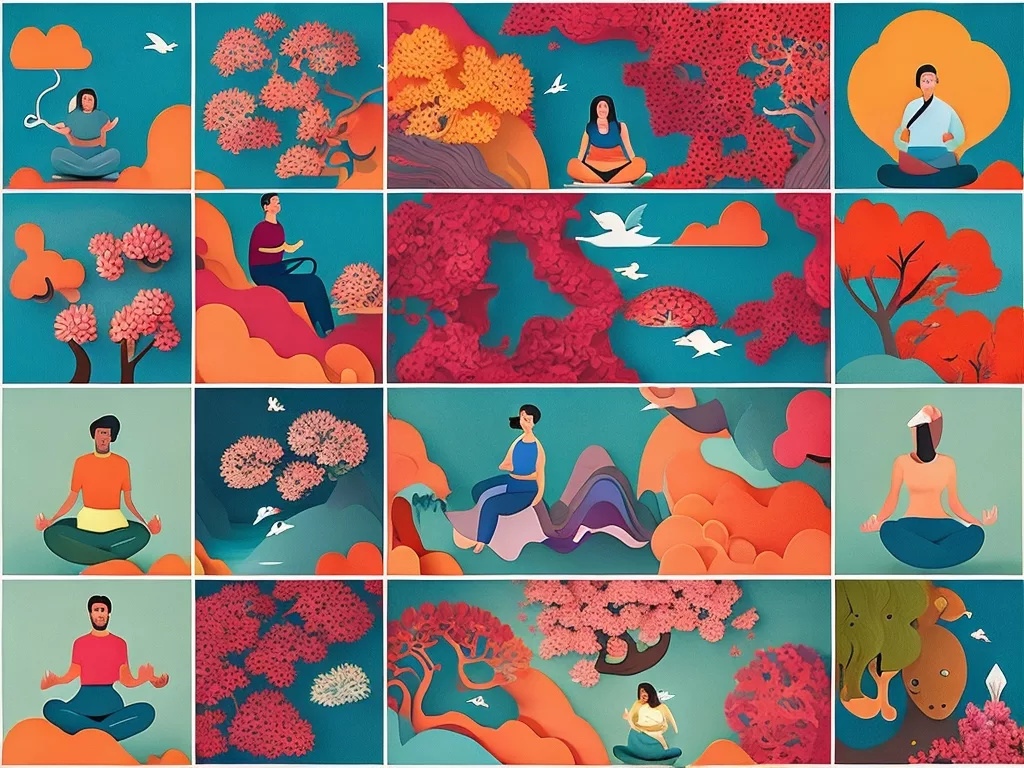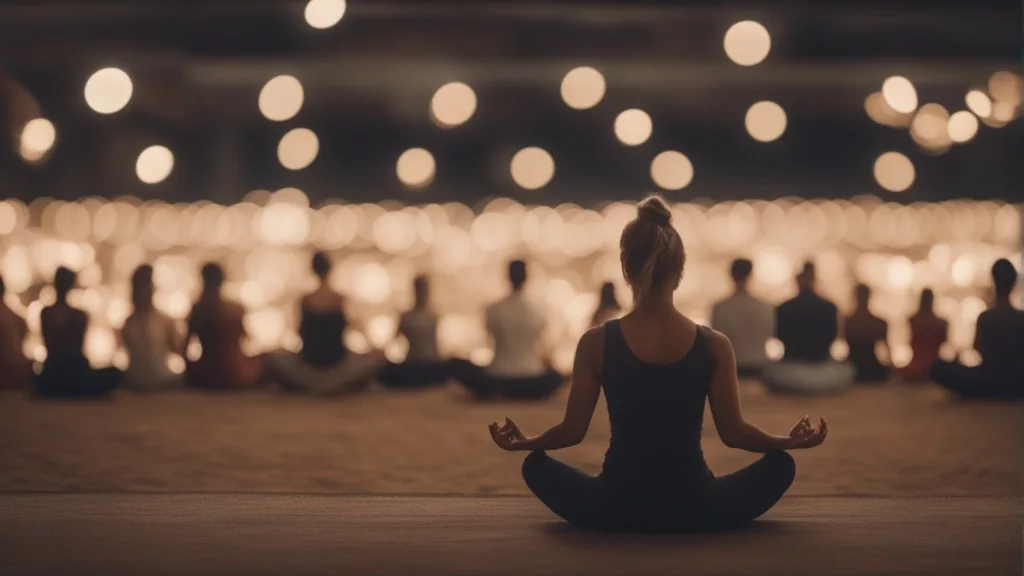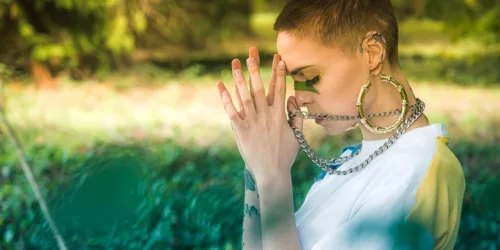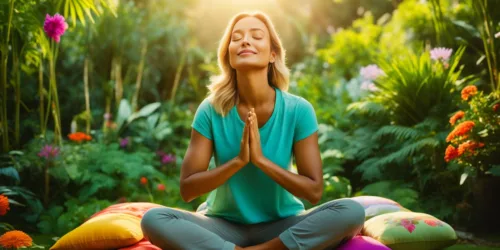Meditation Positions: The Best Positions for Improved Mindfulness

You may think meditation is simply sitting and closing your eyes, but the position you choose makes a difference.
Don’t be fooled into thinking that any one pose is better than another; there are many ways to meditate effectively and each person must find what works best for them.
In this article, we will explore why your meditation position matters, as well as the keys to finding an effective posture.
You’ll learn how to properly practice sitting, lying down, standing and walking (or running) positions so that you can get the most out of your meditation practice.
Key Takeaways
- Properly arranging your body supports mental clarity.
- Sitting in a chair can be just as beneficial as sitting cross-legged.
- Meditation practice is accessible to all, regardless of health or flexibility.
- There are various meditation positions to choose from, including quarter lotus, half lotus, full lotus, Burmese position, chair meditation, and Seiza pose.
Why Does Your Meditation Position Matter
Your meditation position matters because it can influence how relaxed and alert you are, and help you achieve a successful meditation practice. Benefits of proper posture include improved mental clarity and physical comfort.
To find the best position for your body, try dropping your shoulders down and back to open the chest, tucking the chin slightly, and relaxing the jaw. Any hand positions that maintain balance are fine. Experimenting with different poses is also helpful – from quarter lotus to Burmese position to chair meditation – so you can figure out what works best for you.
If you have physical limitations, try adapting poses or using props like a cushion or bench for support. Paying attention to your posture as well as focusing on breath awareness will help further cultivate mental clarity during meditation sessions.
Keys to Meditation Posture

Maintaining an upright spine with a slight curve in the lower back is key to good posture during meditation. Properly arranged body and mind can support mental clarity, so it’s important to find a comfortable position that balances calm and alertness.
To reap the full benefits of meditating, consider dropping your shoulders down and back to open the chest, tucking the chin slightly, and relaxing your jaw. There are many common mistakes people make when attempting meditation postures, such as having their knees above their hips or leaning too far forward. Fortunately, there are numerous modifications for beginners which can help you find comfort while exploring different positions for different purposes.
The quarter lotus pose is popular among those just starting out; sit criss-cross applesauce with each foot below the opposite knee and use a cushion to lift your hips up while maintaining proper posture. For more advanced practitioners who have greater flexibility, half lotus and full lotus poses offer stability and symmetry – although they should be avoided if you have any knee or hip conditions.
The Burmese position requires sitting on the floor with both feet resting in front of the pelvis; this simple yet comfortable pose is ideal if your knees can naturally rest on the ground. Chair meditation is also an option that provides similar benefits as sitting cross-legged without putting pressure on joints or muscles. Finally, Seiza Pose involves kneeling (with a bench or cushion between legs) to generate balance and centering by focusing on sitting bones before settling into a comfortable position that supports proper posture.
Overall, when selecting a meditation position it’s best to start slow: experiment with cushions or objects for support, adjust until you feel comfortable but still alert enough not to fall asleep! With regular practice and patience over time you’ll soon master all these beneficial postures!
Meditation Pose 1 – Quarter Lotus
Sitting criss-cross applesauce with each foot below the opposite knee, quarter lotus is a great place to start for those just beginning their meditation journey. With its upright spine and slight curve in the lower back, it provides balance between calm and alertness. A cushion can be used to lift the hips and support proper posture, while making sure your knees stay lower than your hips.
For those who want more of a challenge, you can work up to half lotus or full lotus posture, although these poses require more hip flexibility and should only be attempted after warming up with yoga poses such as pigeon or reverse pigeon.
If these options are inaccessible due to physical limitation or discomfort, Burmese position or chair meditation may be viable alternatives. And if you’re struggling to find equilibrium while sitting on the floor, seiza pose gives an opportunity for centering on your sitting bones without leaning too far forward.
Chair meditation offers all the same benefits as sitting cross-legged and requires feet shoulder-width apart with shins perpendicular when seated closer at the edge of the chair – adding a pillow or cushion will make it straight-backed.
Explore different positions along with different objects for support until you find one that works best for you!
Meditation Pose 2 – Half Lotus
Half Lotus is similar to quarter lotus, but requires more flexibility as one foot rests on top of the opposite thigh. This pose offers many benefits, including stability and symmetry which can be difficult to achieve with other poses.
To prepare for Half Lotus, try warmup poses like Pigeon pose or reverse pigeon. It’s important to take time to ensure your body is ready before attempting this position. If you don’t have enough hip flexibility for Full Lotus, Half Lotus can be a great alternative.
Chair meditation also provides many of the same benefits as sitting cross-legged and is an ideal option if you experience discomfort while sitting on the floor. Seiza Pose is another alternative that involves kneeling with a bench or cushion between the legs or without support with legs resting on themselves. Tops of feet should be flat against the ground for optimal comfort in this position.
With any of these options, make sure to find a comfortable balance between calmness and alertness that supports proper posture throughout your practice.
Meditation Pose 3 – Full Lotus
Full Lotus is the most difficult posture for beginners, requiring significant lower body flexibility as each foot is placed on the opposite thigh. This posture provides stability and symmetry, allowing you to explore a sense of equilibrium and centering on your sitting bones. However, it should be avoided if you have knee or hip conditions.
Although challenging, the benefits of full lotus position are numerous: it is an excellent way to cultivate mental and physical relaxation, tranquility, awareness, and power.
Alternative meditation positions include quarter lotus (each foot below the opposite knee) and half lotus (one foot resting on top of the opposite thigh). These also require hip flexibility to avoid knee joint pressure. It’s important to prepare your body before attempting these poses by using yoga poses such as pigeon pose or reverse pigeon as a warmup.
Chair meditation can offer similar benefits when done correctly – feet shoulder-width apart with shins perpendicular to the floor; use a pillow or cushion for straight-backed seating. Seiza pose requires kneeling with a bench or cushion between legs; tops of feet flat against the ground for comfort.
Standing meditation involves holding postures from 2-3 minutes up to 10-15 minutes a day while paying attention to breath movement and sensations in the body. Walking meditations are great for mindful living while incorporating visualization techniques into daily life.
Exploring different sitting positions can help find what works best for you; remember that Full Lotus may not be achievable if lacking flexibility or having medical issues, so other options should be explored too! Avoid leaning too far forward in any seated position to prevent pressure on legs and feet – find a comfortable balance between calmness and alertness instead!
Meditation Pose 4 – Burmese Position
Try the Burmese position for a simple and comfortable pose if your knees can naturally rest on the ground. Benefits of this position include finding equilibrium and centering on sitting bones.
To maintain proper posture, make sure you don’t lean too far forward to prevent pressure on legs and feet. Experiment with different positions on your cushion to find comfort.
Alternatives to Burmese position include Quarter Lotus, Half Lotus, Full Lotus, Chair Meditation, and Seiza Pose. For beginners, use a meditation bench or cushion between the legs to support the body weight as you learn how to sit in this posture.
Here are some tips for finding comfort in the Burmese position:
- Maintain an upright spine with slight curve in lower back
- Drop shoulders down and back to open chest
- Tuck chin slightly and relax jaw
- Any hand position that maintains balance is fine
- Focus on finding a comfortable balance between calmness & alertness
Meditation Pose 5 – Chair Meditation
Take a seat and experience the benefits of chair meditation. Chair meditation is accessible for all levels and provides the same mental clarity as seated positions. You can modify the posture to find balance in comfort and alertness. Incorporate mindful sitting into daily life by using props for support or dedicating a chair specifically to meditation.
| Benefits | Modifications |
|---|---|
| Upright spine, slight curve in lower back | Feet shoulder-width apart on floor, shins perpendicular Pillow/cushion behind lower back for straight posture Hand positions on legs or lap |
| Open chest, relaxed jaw & chin tucked slightly in | Sit close to edge of chair for upright spine Experiment with different positions on cushion |
| Balanced calm & alertness | Use wall/sturdy furniture for back support Dedicate one chair specifically to meditation practice |
| Accessible to all regardless of health/flexibility | Use yoga poses like pigeon pose before attempting full lotus Prepare body before attempting more difficult postures Adjust as needed for comfort&balance |
Meditation Pose 6 – Seiza Pose
Kneeling with a meditation bench or cushion between the legs, seiza pose is a common meditation position in the Japanese tradition. This pose requires flexibility and balance to sit upright and find comfort while meditating. Here are some tips for modifications, benefits, and finding comfort in this unique posture:
- Seiza modifications: Use a bench or cushion to support the knees; if needed, kneel without support by resting the legs on themselves.
- Benefits of seiza pose: Encourages good posture and symmetrical balance; promotes focus in thought and action.
- Seiza vs other poses: Requires more flexibility than chair meditation but slightly less than lotus positions; holds same benefits as other postures.
- How to find comfort: Position tops of feet flat against ground; adjust as needed until comfortable; use pillow under head if desired.
- Seiza for beginners: Start slowly with short sessions and gradually increase time spent meditating; practice yoga poses for hip flexibility before attempting this pose.
Sitting Meditation Positions

You can find a comfortable and balanced meditation posture by exploring seated positions such as sitting in an upright chair, using a cushion on the floor, or leaning against a wall.
The benefits of sitting meditation include improved concentration and focus, increased energy levels, better physical posture, enhanced relaxation, and stress relief.
Different hand positions can be used to enhance your practice; experiment with placing your hands on your legs or resting them in your lap.
Additionally, finding the right cushion for meditation is essential; it should provide enough lift to keep the hips above the knees while keeping the spine straight.
For those with knee or hip conditions there are modifications available such as using a thin pillow under the head when lying down or utilizing props like blocks or chairs to support different poses.
You can also incorporate mindfulness into daily activities like grocery shopping by paying attention to breath movement while walking around.
Sitting meditation helps create stillness and clarity that transitions nicely into lying down meditation.
Lying Down Meditation
Lying down meditation can be an excellent way to relax and focus your mind. It has many benefits, such as reducing stress levels and improving mental clarity. Here are some tips for maintaining focus during lying down meditation:
- Lie flat on the floor with legs hip-width apart and arms extended alongside the body.
- Place a thin pillow under the head and bend the knees to 90 degrees for comfort.
- Use a mat or blanket on the floor to prevent drowsiness.
- Practice sleep meditation in a comfortable bed if desired.
- Focus on your breath while visualizing something calming, like a peaceful beach or majestic mountain range.
Different variations of lying down meditation positions include crook lying – where you lie on your back with knees bent at 90 degrees and aligned with the spine, soles of feet resting on bed – and utilizing visualization techniques to focus on breath movement while standing or running. This is another form of meditation known as mindful movement.
To create a comfortable space for lying down meditation, make sure you have enough room to lie comfortably without distractions from pets or other people in your home. Incorporating visualization techniques into this type of meditation can help bring mindfulness into daily life through creative imagery that heightens awareness of body sensations associated with relaxation and peacefulness.
Standing Meditation Positions
Standing meditation can help cultivate mental and physical relaxation, tranquility, awareness, and power. It involves standing with feet hip-to-shoulder-width apart, knees slightly bent, and arms raised to mid-chest height.
Alternatively, you can stand with feet shoulder width apart, hands over the belly while focusing on breath movement. You can also take a more mindful approach by standing legs shoulder width apart with feet parallel and focusing on sensations at the base of the feet or crown of the head.
Holding standing postures for a few minutes each day gradually increases your meditation time from 2-3 minutes to 10-15 minutes daily.
Incorporating movement in meditation like walking or running is another great way to bring mindfulness into everyday life. Pay attention to your body’s sensations as you explore visualization techniques while walking or running in public places such as grocery stores or waiting in line.
Moving meditation is an excellent way to reduce stress and increase alertness. Transitioning from standing positions into walking (or running) positions is an effective way to find balance between calmness and alertness through your practice.
Walking (or Running) Positions
Walking or running can be a great way to bring mindfulness into your everyday life. By incorporating mindful movement, you can create an awareness of the body and benefit from the physical exercise. Here are some tips on how to use walking or running for meditation:
- Mindful movement: Focus on connecting with your breath and body while walking or running.
- Benefits of walking meditation: Bring awareness to your movements, focus on sensations in the body, and practice gratitude for being able to move.
- Incorporating mindfulness into exercise: Notice thoughts that arise during activity but don’t get caught up in them; instead, stay focused on the present moment.
- Mind body connection in running: Concentrate on breathing patterns and observe any emotions that surface during activity.
- Mindful walking in public spaces: Even when out in public, it is possible to remain aware of thoughts and feelings while maintaining a sense of calmness and presence.
Frequently Asked Questions
What Is the Best Meditation Position for Beginners?
For beginners, the best meditation position is one that promotes physical relaxation and mental focus. Focus on finding a comfortable balance that supports both spiritual awareness exercises and guided meditation practice. Benefits include increased clarity and focus, greater physical relaxation, and improved overall wellbeing.
What Is the Difference Between Seated, Lying Down, Standing, and Walking Meditation?
Seated meditation offers yoga benefits, guided visualization and mindful breathing. Lying down can be used to relax the body. Standing meditation is great for cultivating mental and physical relaxation. Walking meditation focuses on breath movement, mindful eating and mindful walking.
How Should I Adjust My Hand Position for Meditation?
Focus your breathing, explore chakras with mindful movement, and release stress through body awareness. Find a comfortable hand position that encourages focused energy while meditating.
Are There Any Special Techniques for Meditation for Specific Purposes?
Yes, there are special techniques for meditation for specific purposes. Focusing Techniques, Mindful Breathing, Chanting Mantras, Visualization Exercises and Meditation Music can all be used to reach a desired outcome. Each technique has its own unique benefits that can help you achieve the goal you have set out to accomplish.
What Are Some of the Best Resources to Learn More About Meditation?
Time-honored methods like meditative breathing, mindfulness tips, guided meditation and relaxation methods can help you unlock the power of meditation. Explore yoga postures, discover new techniques and find a practice that works for you!
Conclusion
It’s important to find the right meditation position for you. With a variety of poses, from quarter lotus to full lotus, sitting to standing and even walking, you can explore your options until you find one that works best.
Remember: practice makes perfect. As they say, ‘Rome wasn’t built in a day,’ so don’t expect perfection right away—it will come with patience and perseverance!
With dedication and focus, you’ll soon be able to sit still like a stone statue and enjoy the peace and tranquility of meditating.






